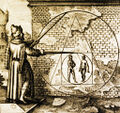Template:Selected anniversaries/January 31: Difference between revisions
Jump to navigation
Jump to search
No edit summary |
No edit summary |
||
| Line 4: | Line 4: | ||
File:Jost Bürgi.jpg|link=Jost Bürgi (nonfiction)|1632: Clockmaker and mathematician [[Jost Bürgi (nonfiction)|Jost Bürgi]] dies. He was recognized during his own lifetime as one of the most excellent mechanical engineers of his generation. | File:Jost Bürgi.jpg|link=Jost Bürgi (nonfiction)|1632: Clockmaker and mathematician [[Jost Bürgi (nonfiction)|Jost Bürgi]] dies. He was recognized during his own lifetime as one of the most excellent mechanical engineers of his generation. | ||
||1715: The 1715 Treasure Fleet was a Spanish treasure fleet returning from the New World to Spain. At two in the morning on Wednesday, July 31, 1715, seven days after departing from Havana, Cuba, under the command of Juan Esteban de Ubilla, eleven of the twelve ships of this fleet were lost in a hurricane near present-day Vero Beach, Florida. Because the fleet was carrying silver, it is also known as the 1715 Plate Fleet (plata being the Spanish word for silver). Around 1,500 (confirmed by Cuban records) sailors perished while a small number survived on lifeboats. | ||1715: The 1715 Treasure Fleet was a Spanish treasure fleet returning from the New World to Spain. At two in the morning on Wednesday, July 31, 1715, seven days after departing from Havana, Cuba, under the command of Juan Esteban de Ubilla, eleven of the twelve ships of this fleet were lost in a hurricane near present-day Vero Beach, Florida. Because the fleet was carrying silver, it is also known as the 1715 Plate Fleet (plata being the Spanish word for silver). Around 1,500 (confirmed by Cuban records) sailors perished while a small number survived on lifeboats. | ||
| Line 22: | Line 20: | ||
||1868: Theodore William Richards born ... chemist and academic, Nobel Prize laureate. Pic (cool tech). | ||1868: Theodore William Richards born ... chemist and academic, Nobel Prize laureate. Pic (cool tech). | ||
||1881: Irving Langmuir born ... chemist and physicist, Nobel Prize laureate. Pic. | ||1881: Irving Langmuir born ... chemist and physicist, Nobel Prize laureate. Pic. | ||
| Line 48: | Line 44: | ||
||1932: Physicist Charles S. Hastings born. known for his work in optics. Pic search. | ||1932: Physicist Charles S. Hastings born. known for his work in optics. Pic search. | ||
||1934: Duncan MacLaren Young Sommerville dies ... mathematician and astronomer. He compiled a bibliography on non-Euclidean geometry and also wrote a leading textbook in that field. He also wrote Introduction to the Geometry of N Dimensions, advancing the study of polytopes. Pic. | ||1934: Duncan MacLaren Young Sommerville dies ... mathematician and astronomer. He compiled a bibliography on non-Euclidean geometry and also wrote a leading textbook in that field. He also wrote Introduction to the Geometry of N Dimensions, advancing the study of polytopes. Pic. | ||
| Line 77: | Line 71: | ||
||1980: Emanuel Sperner dies ... mathematician. He proposed Sperner's theorem, which says that the size of an antichain in the power set of an n-set (a Sperner family) is at most the middle binomial coefficient(s). Pic. | ||1980: Emanuel Sperner dies ... mathematician. He proposed Sperner's theorem, which says that the size of an antichain in the power set of an n-set (a Sperner family) is at most the middle binomial coefficient(s). Pic. | ||
||1995: George Stibitz dies ... Bell Labs researcher internationally recognized as one of the fathers of the modern first digital computer. He was known for his work in the 1930s and 1940s on the realization of Boolean logic digital circuits using electromechanical relays as the switching element. Pic. | ||1995: George Stibitz dies ... Bell Labs researcher internationally recognized as one of the fathers of the modern first digital computer. He was known for his work in the 1930s and 1940s on the realization of Boolean logic digital circuits using electromechanical relays as the switching element. Pic. | ||
Revision as of 18:41, 19 January 2022
1632: Clockmaker and mathematician Jost Bürgi dies. He was recognized during his own lifetime as one of the most excellent mechanical engineers of his generation.
1971: The Winter Soldier Investigation, organized by the Vietnam Veterans Against the War to publicize war crimes and atrocities by Americans and allies in Vietnam, begins in Detroit.
2001: American comic book artist Gil Kane dies. Kane pioneered graphic novels with his books His Name is...Savage (1968) and Blackmark (1971).
2002: Anarchimedes uses Gnomon algorithm to commit crimes against mathematical constants.
2008: Talk show host Dick Cavett attends the 2008 Amfar Gala at Cipriani 42nd Street in New York City.





